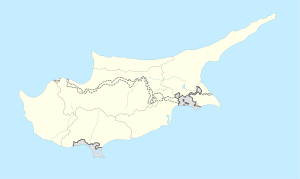This article needs additional citations for verification. (January 2021) |
Stylloi (Greek: Στύλλοι, Turkish: Mutluyaka) is a village in the Famagusta District of Cyprus, located 12 km northwest of Famagusta. It is under the de facto control of Northern Cyprus.
Stylloi | |
|---|---|
village | |
| Στύλλοι (Greek) Mutluyaka (Turkish) | |
| Coordinates: 35°10′17″N 33°50′1″E / 35.17139°N 33.83361°E | |
| Country (de jure) | |
| • District | Famagusta District |
| Country (de facto) | |
| • District | Gazimağusa District |
| Time zone | UTC+2 (EET) |
| • Summer (DST) | UTC+3 (EEST) |
Archaeological Excavations
editClose to the modern village of Stylloi the Swedish Cyprus Expedition, led by Einar Gjerstad, excavated a necropolis. The site was known before and Mr. Rubert Gunnis, inspector of Antiquities in Cyprus, excavated here in 1928. The Swedish excavations commenced at the highest part of the terrace and thereafter continued on the southern slope. During this excavation, the Crown Prince of Sweden, Gustaf VI Adolf visited the site and excavated himself.[2]
The tombs on the plateau, where the ground mainly consists of the local chavara, have all spacious dromoi and are from a typical point of view rather different from the ones on the southern slope. The former is long with a more or less regularly sloping floor, in some cases stairs are preserved. The latter are much shorter and widen much more abruptly. Their floor is horizontal. Both types have irregular chambers that usually are smaller than the big dromos. The burial customs are the same in all tombs. The buried were found outstretched on their back, surrounded by burial gifts. Coffins were not used. The burial place was used from Cypro-Geometric IIIA until Cypro-Archaic IIA. During the Cypro-Geometric period until Cypro-Archaic I the burials were made at the plateau. In the following periods, these tombs were reused at the same time as the southern slope became more popular.
References
edit- ^ In 1983, the Turkish Republic of Northern Cyprus unilaterally declared independence from the Republic of Cyprus. The de facto state is not recognised by any UN state except Turkey.
- ^ Gjerstad, Einar (1935). The Swedish Cyprus Expedition Publications Finds and Results of the Excavations in Cyprus 1927-1931, Vol. II. Text. Stockholm: Victor Pettersons Bokindustriaktiebolag. pp. 2–4, 138–141, 625, 179–180, 626–628, 643, 820–24.
